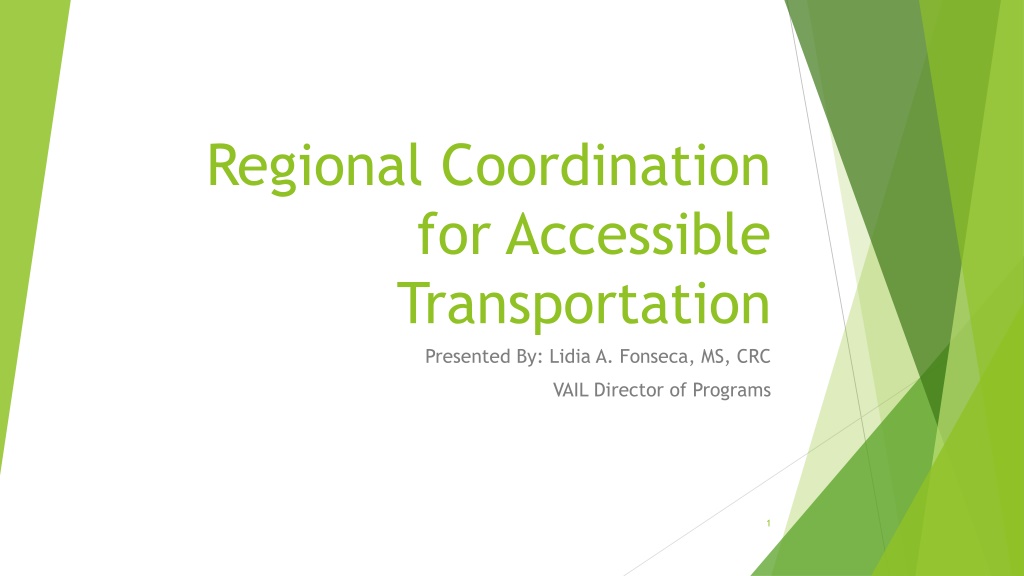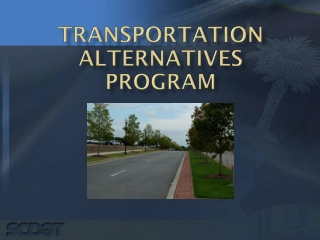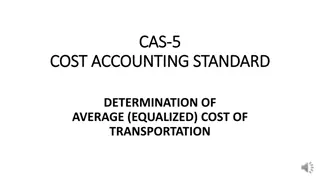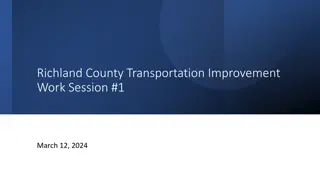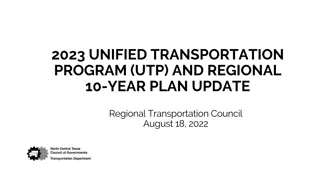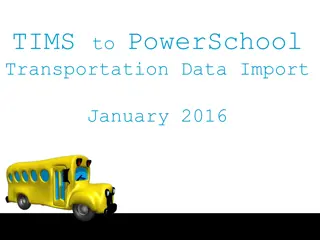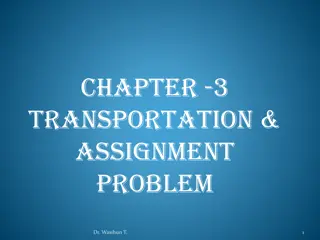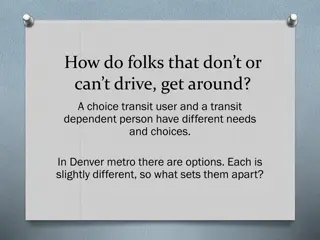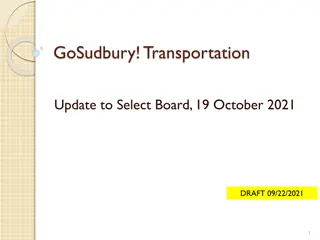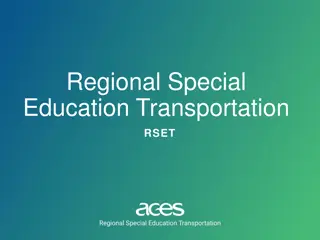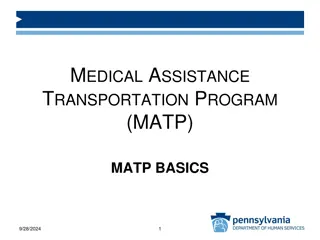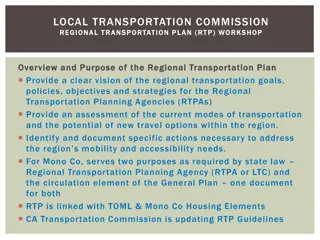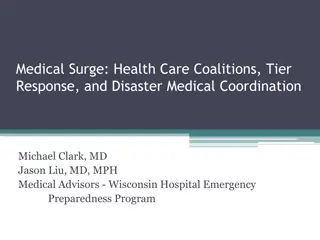Understanding Regional Coordination for Accessible Transportation
This presentation delves into the concept of regional coordination in accessible transportation, focusing on the Regional Transportation Advisory Panel, 5-year regional transportation goals, and the significance of the Safe, Accountable, Flexible, Efficient Transportation Equity Act. It emphasizes the importance of transit agencies, community organizations, and stakeholders coming together to address transportation barriers and enhance the overall transportation experience for riders. The discussion also covers the development of coordinated public transit-human service transportation plans and the requirements set forth by federal legislation.
- Accessible transportation
- Regional coordination
- Transit agencies
- SAFETEA-LU legislation
- Coordinated transportation
Download Presentation

Please find below an Image/Link to download the presentation.
The content on the website is provided AS IS for your information and personal use only. It may not be sold, licensed, or shared on other websites without obtaining consent from the author. Download presentation by click this link. If you encounter any issues during the download, it is possible that the publisher has removed the file from their server.
E N D
Presentation Transcript
Regional Coordination for Accessible Transportation Presented By: Lidia A. Fonseca, MS, CRC VAIL Director of Programs 1
Discussion Items Defining Regional Transportation Coordination RTAP (Regional Transportation Advisory Panel) 5 year Regional Transportation Plan Goals and Measurable Outcomes of the plan 2
What is Regional Coordination Transit agencies, community organizations and other stakeholders in the region meet to discuss transportation barriers, options, and ideas for creating a smooth transportation process for riders and implement into the transportation plan. 3
Standard/Policy on Regional Coordination for Accessible Transportation In August 2005, Congress passed the Safe, Accountable, Flexible, Efficient Transportation Equity Act: A Legacy for Users (SAFETEA-LU), legislation that provides funding for highway and transit programs. SAFETEA-LU includes new planning requirements for the FTA Section 5310 (Elderly Individuals and Individuals with Disabilities) and other programs, requiring that projects funded through these programs must be derived from a locally developed, coordinated public transit-human services transportation plan. 4
Standard/Policy on Regional Coordination for Accessible Transportation Continued This provision is aimed at improving transportation services for persons with disabilities, older adults, and individuals with lower incomes, and ensuring that communities are coordinating transportation resources provided through multiple federal programs. 5
Standard/Policy on Regional Coordination for Accessible Transportation Continued In 2005, the TxDOT Strategic Plan called for the development of regional public transportation coordination plans based on the SAFETEA- LU legislation. 6
What is a Coordinated Public Transit- Human Service Transportation Plan? Federal Coordinated Transportation Plan Elements/Requirements FTA guidance defines this as one that identifies the transportation needs of individuals with disabilities, older adults, and people with low incomes; provides strategies for meeting those needs; and prioritizes transportation services for funding and implementation. 7
Current Standard on Regional Coordination for Accessible Transportation On July 6, 2012, President Obama signed into law Moving Ahead for Progress in the 21st Century (MAP-21) which went into effect on October 1, 2012. This legislation continued the coordinated transportation planning requirements for the Section 5310 Program administered by FTA. 8
What changed? The MAP-21 law consolidates the Elderly and Disabled and New Freedom programs. New provisions modify funding formulas and eligibility requirements for the consolidated Section 5310 program. The purpose of the Section 5310 Program is to enhance mobility for seniors and persons with disabilities by providing funds for programs to serve the special needs of transit-dependent populations beyond traditional public transportation services and Americans with Disabilities Act (ADA) complementary paratransit services. 9
Regional Transportation Advisory Panel (RTAP) The Lower Rio Grande Valley Regional Public Transportation Advisory Panel (RTAP) is to improve the coordinated delivery of public transportation in the Lower Rio Grande Valley of Texas. The goals of the RTAP are to: A. Generate efficiencies that encourage and increase public transportation ridership growth, B. Improve customer/rider satisfaction, C. Foster cooperation and coordination between stakeholders, D. Share resources and knowledge, and E. Advocate for regional objectives. Each member of the RTAP works for the good of regional coordination. 10
RTAP Membership The RTAP is composed of stakeholders who have an interest in promoting public transportation in the region. Current membership includes, but is not limited to, representatives of the following agencies: A. Public transportation agencies, B. Private transportation agencies, C. Human service agencies, D. Workforce boards, E. Metropolitan Planning Organizations, F. Veterans groups, G. Aging and disability service agencies, H. Adult day care and assisted living organizations, I. Medical transportation agencies, J. Universities and educational institutions K. Elected Officials, L. Municipalities and counties, and 11 M. Other Interested Parties
Lower Rio Grande Valley Regional Public Transportation Coordination Plan The goal of this plan is to encourage the implementation of activities that foster improved public and human service transportation. Planning efforts are directed toward effectively and efficiently increasing service through coordination with an emphasis on transit dependent and Title VI populations and veterans. These categories include: Elderly Persons with disabilities Low income residents Zero car households Youths Veterans Non-English speaking residents (Title VI) 12
The following are areas that the RTAP reviews An assessment of available services that identifies current transportation providers (public, private and nonprofit). An assessment of transportation needs for individuals with disabilities and seniors. This assessment can be based on the experiences and perceptions of the planning partners or on more sophisticated data collection efforts, and gaps in service. Strategies, activities, and/or projects to address the identified gaps between current services and needs, and opportunities to achieve efficiencies in service delivery. Priorities for implementation based on resources (from multiple program sources), time and feasibility for implementing specific strategies and/or activities identified. 14
How can you get involved in transportation coordination in your region? 15
Questions? Contact Information Lidia A. Fonseca, MS, CRC VAIL Director of Programs (956) 668-8245, ext 309 lfonseca@vailrgv.org 16
